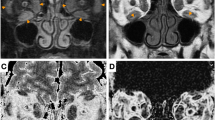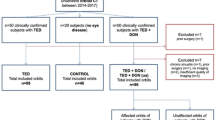Abstract
Introduction
To investigate the extraocular muscle (EOM) changes in thyroid-associated orbitopathy (TAO) on DTI and the correlations between DTI parameters and clinical features.
Methods
Twenty TAO patients and 20 age- and sex-matched controls provided informed consent and were enrolled. Ten-directional DTI was acquired in orbit. Fractional anisotropy (FA), mean, axial, and radial diffusivities were obtained at medial and lateral EOMs in both orbits. EOM thickness was measured in patients using axial CT images. FA and diffusivities were compared between patients and controls. The relationships between DTI values and muscle thickness and exophthalmos were evaluated. DTI values compared between patients in active and inactive phases by clinical activity score of TAO. DTI values were also compared between acute and chronic stages by the duration of disease.
Results
In medial EOM, FA was significantly lower in patients (p < 0.001) and negatively correlated with muscle thickness (r = −0.604, p < 0.001). Radial diffusivity was significantly higher in patients (p = 0.010) and correlated with muscle thickness (r = 0.349, p = 0.027). In lateral EOM, DTI values did not differ between patients and controls. In the acute stage, the diffusivities of the medial rectus EOM were increased compared with the chronic stage. DTI values of the medial and lateral rectus EOM did not differ significantly between active and inactive phases.
Conclusion
DTI can be used to diagnose TAO with FA and radial diffusivity change in EOM. Diffusivities can be used to differentiate acute and chronic stage of TAO. However, DTI values showed limitation in reflecting TAO activity according to the CAS.



Similar content being viewed by others
References
Mengistu M, Lukes YG, Nagy EV, Burch HB, Carr FE, Lahiri S, Burman KD (1994) TSH receptor gene expression in retroocular fibroblasts. J Endocrinol Investig 17(6):437–441. doi:10.1007/BF03347732
Esposito A, Campana L, Palmisano A, De Cobelli F, Canu T, Santarella F, Colantoni C, Monno A, Vezzoli M, Pezzetti G, Manfredi AA, Rovere-Querini P, Del Maschio A (2013) Magnetic resonance imaging at 7 T reveals common events in age-related sarcopenia and in the homeostatic response to muscle sterile injury. PLoS One 8(3):e59308. doi:10.1371/journal.pone.0059308
Maheshwari R, Weis E (2012) Thyroid associated orbitopathy. Indian J Ophthalmol 60(2):87–93. doi:10.4103/0301-4738.94048
Jiang H, Wang Z, Xian J, Li J, Chen Q, Ai L (2012) Evaluation of rectus extraocular muscles using dynamic contrast-enhanced MR imaging in patients with Graves’ ophthalmopathy for assessment of disease activity. Acta Radiol 53(1):87–94. doi:10.1258/ar.2011.110431
Fells P, Kousoulides L, Pappa A, Munro P, Lawson J (1994) Extraocular muscle problems in thyroid eye disease. Eye (London, England) 8(Pt 5):497–505. doi:10.1038/eye.1994.125
Muller-Forell W, Pitz S (2004) Orbital pathology. Eur J Radiol 49(2):105–142
Parmar H, Ibrahim M (2008) Extrathyroidal manifestations of thyroid disease: thyroid ophthalmopathy. Neuroimaging Clin N Am 18(3):527–536 . doi:10.1016/j.nic.2008.03.003viii-ix
Bahn RS (2010) Graves’ ophthalmopathy. N Engl J Med 362(8):726–738. doi:10.1056/NEJMra0905750
Goncalves AC, Gebrim EM, Monteiro ML (2012) Imaging studies for diagnosing Graves’ orbitopathy and dysthyroid optic neuropathy. Clinics 67(11):1327–1334
Tortora F, Cirillo M, Ferrara M, Belfiore MP, Carella C, Caranci F, Cirillo S (2013) Disease activity in Graves’ ophthalmopathy: diagnosis with orbital MR imaging and correlation with clinical score. Neuroradiol J 26(5):555–564
Fledelius HC, Zimmermann-Belsing T, Feldt-Rasmussen U (2003) Ultrasonically measured horizontal eye muscle thickness in thyroid associated orbitopathy: cross-sectional and longitudinal aspects in a Danish series. Acta Ophthalmol Scand 81(2):143–150
Hosten N, Sander B, Cordes M, Schubert CJ, Schorner W, Felix R (1989) Graves ophthalmopathy: MR imaging of the orbits. Radiology 172(3):759–762. doi:10.1148/radiology.172.3.2772184
Rodriguez-Gonzalez N, Perez-Rico C, Lopez-Para Gimenez R, Arevalo-Serrano J, Del Amo GB, Calzada Domingo L, Flores Ruiz L, Blanco R (2011) Short-tau inversion-recovery (STIR) sequence magnetic resonance imaging evaluation of orbital structures in Graves’ orbitopathy. Archivos de la Sociedad Espanola de Oftalmologia 86(11):351–357. doi:10.1016/j.oftal.2011.06.010
Cakirer S, Cakirer D, Basak M, Durmaz S, Altuntas Y, Yigit U (2004) Evaluation of extraocular muscles in the edematous phase of graves ophthalmopathy on contrast-enhanced fat-suppressed magnetic resonance imaging. J Comput Assist Tomogr 28(1):80–86
Mayer EJ, Fox DL, Herdman G, Hsuan J, Kabala J, Goddard P, Potts MJ, Lee RW (2005) Signal intensity, clinical activity and cross-sectional areas on MRI scans in thyroid eye disease. Eur J Radiol 56(1):20–24. doi:10.1016/j.ejrad.2005.03.027
Basser PJ, Pierpaoli C (1996) Microstructural and physiological features of tissues elucidated by quantitative-diffusion-tensor MRI. Journal of magnetic resonance Series B 111(3):209–219
Basser PJ, Mattiello J, LeBihan D (1994) MR diffusion tensor spectroscopy and imaging. Biophys J 66(1):259–267. doi:10.1016/S0006-3495(94)80775-1
Heemskerk AM, Strijkers GJ, Vilanova A, Drost MR, Nicolay K (2005) Determination of mouse skeletal muscle architecture using three-dimensional diffusion tensor imaging. Magn Reson Med 53(6):1333–1340. doi:10.1002/mrm.20476
Tseng WY, Wedeen VJ, Reese TG, Smith RN, Halpern EF (2003) Diffusion tensor MRI of myocardial fibers and sheets: correspondence with visible cut-face texture. Journal of magnetic resonance imaging : JMRI 17(1):31–42. doi:10.1002/jmri.10223
Galban CJ, Maderwald S, Uffmann K, de Greiff A, Ladd ME (2004) Diffusive sensitivity to muscle architecture: a magnetic resonance diffusion tensor imaging study of the human calf. Eur J Appl Physiol 93(3):253–262. doi:10.1007/s00421-004-1186-2
Heemskerk AM, Drost MR, van Bochove GS, van Oosterhout MF, Nicolay K, Strijkers GJ (2006) DTI-based assessment of ischemia-reperfusion in mouse skeletal muscle. Magn Reson Med 56(2):272–281. doi:10.1002/mrm.20953
McMillan AB, Shi D, Pratt SJ, Lovering RM (2011) Diffusion tensor MRI to assess damage in healthy and dystrophic skeletal muscle after lengthening contractions. Journal of biomedicine & biotechnology 2011:970726. doi:10.1155/2011/970726
Qi J, Olsen NJ, Price RR, Winston JA, Park JH (2008) Diffusion-weighted imaging of inflammatory myopathies: polymyositis and dermatomyositis. Journal of magnetic resonance imaging : JMRI 27(1):212–217. doi:10.1002/jmri.21209
Zaraiskaya T, Kumbhare D, Noseworthy MD (2006) Diffusion tensor imaging in evaluation of human skeletal muscle injury. Journal of magnetic resonance imaging : JMRI 24(2):402–408. doi:10.1002/jmri.20651
Wu Y, Zhang LJ, Zou C, Tse HF, Wu EX (2011) Transmural heterogeneity of left ventricular myocardium remodeling in postinfarct porcine model revealed by MR diffusion tensor imaging. Journal of magnetic resonance imaging : JMRI 34(1):43–49. doi:10.1002/jmri.22589
Kilicarslan R, Alkan A, Ilhan MM, Yetis H, Aralasmak A, Tasan E (2015) Graves’ ophthalmopathy: the role of diffusion-weighted imaging in detecting involvement of extraocular muscles in early period of disease. Br J Radiol 88(1047):20140677. doi:10.1259/bjr.20140677
Politi LS, Godi C, Cammarata G, Ambrosi A, Iadanza A, Lanzi R, Falini A, Bianchi Marzoli S (2014) Magnetic resonance imaging with diffusion-weighted imaging in the evaluation of thyroid-associated orbitopathy: getting below the tip of the iceberg. Eur Radiol 24(5):1118–1126. doi:10.1007/s00330-014-3103-3
Mourits MP, Koornneef L, Wiersinga WM, Prummel MF, Berghout A, van der Gaag R (1989) Clinical criteria for the assessment of disease activity in Graves’ ophthalmopathy: a novel approach. Br J Ophthalmol 73(8):639–644
Eckstein AK, Plicht M, Lax H, Neuhauser M, Mann K, Lederbogen S, Heckmann C, Esser J, Morgenthaler NG (2006) Thyrotropin receptor autoantibodies are independent risk factors for Graves’ ophthalmopathy and help to predict severity and outcome of the disease. J Clin Endocrinol Metab 91(9):3464–3470. doi:10.1210/jc.2005-2813
Bothun ED, Scheurer RA, Harrison AR, Lee MS (2009) Update on thyroid eye disease and management. Clin Ophthalmol 3:543–551
Mourits MP, Prummel MF, Wiersinga WM, Koornneef L (1997) Clinical activity score as a guide in the management of patients with Graves’ ophthalmopathy. Clin Endocrinol 47(1):9–14
Shah Y (2011) Thyroid ophthalmopathy. J Assoc Physicians India 59(Suppl):60–65
Tournier J-D, Mori S, Leemans A (2011) Diffusion tensor imaging and beyond. Magn Reson Med 65(6):1532–1556. doi:10.1002/mrm.22924
Zhang H, Wang X, Guan M, Li C, Luo L (2013) Skeletal muscle evaluation by MRI in a rabbit model of acute ischaemia. Br J Radiol 86(1026):20120042. doi:10.1259/bjr.20120042
Taouli B, Chouli M, Martin AJ, Qayyum A, Coakley FV, Vilgrain V (2008) Chronic hepatitis: role of diffusion-weighted imaging and diffusion tensor imaging for the diagnosis of liver fibrosis and inflammation. Journal of magnetic resonance imaging : JMRI 28(1):89–95. doi:10.1002/jmri.21227
Taouli B, Tolia AJ, Losada M, Babb JS, Chan ES, Bannan MA, Tobias H (2007) Diffusion-weighted MRI for quantification of liver fibrosis: preliminary experience. AJR Am J Roentgenol 189(4):799–806. doi:10.2214/ajr.07.2086
Cheung JS, Fan SJ, Gao DS, Chow AM, Man K, Wu EX (2010) Diffusion tensor imaging of liver fibrosis in an experimental model. Journal of magnetic resonance imaging : JMRI 32(5):1141–1148. doi:10.1002/jmri.22367
Williams SE, Heemskerk AM, Welch EB, Li K, Damon BM, Park JH (2013) Quantitative effects of inclusion of fat on muscle diffusion tensor MRI measurements. Journal of magnetic resonance imaging : JMRI 38(5):1292–1297. doi:10.1002/jmri.24045
Ponrartana S, Ramos-Platt L, Wren TA, Hu HH, Perkins TG, Chia JM, Gilsanz V (2015) Effectiveness of diffusion tensor imaging in assessing disease severity in Duchenne muscular dystrophy: preliminary study. Pediatr Radiol 45(4):582–589. doi:10.1007/s00247-014-3187-6
Hooijmans MT, Damon BM, Froeling M (2015) Evaluation of skeletal muscle. DTI in patients with duchenne muscular dystrophy 28(11):1589–1597. doi:10.1002/nbm.3427
Rabinowitz MP, Carrasco JR (2012) Update on advanced imaging options for thyroid-associated orbitopathy. Saudi journal of ophthalmology : official journal of the Saudi Ophthalmological Society 26(4):385–392. doi:10.1016/j.sjopt.2012.07.006
Fang ZJ, Zhang JY, He WM (2013) CT features of exophthalmos in Chinese subjects with thyroid-associated ophthalmopathy. International journal of ophthalmology 6(2):146–149. doi:10.3980/j.issn.2222-3959.2013.02.07
Acknowledgments
This study was supported by the Korea University College of Medicine (K1325441) and the Department of Radiology, Korea University College of Medicine (KUMCRG 06142).
Author information
Authors and Affiliations
Corresponding author
Ethics declarations
We declare that all human studies have been approved by the Korea University Ansan Hospital Ethics Committee and have therefore been performed in accordance with the ethical standards laid down in the 1964 Declaration of Helsinki and its later amendments. We declare that all patients gave informed consent prior to inclusion in this study.
Conflict of interest
We declare that we have no conflict of interest.
Rights and permissions
About this article
Cite this article
Han, J.S., Seo, H.S., Lee, Y.H. et al. Fractional anisotropy and diffusivity changes in thyroid-associated orbitopathy. Neuroradiology 58, 1189–1196 (2016). https://doi.org/10.1007/s00234-016-1764-0
Received:
Accepted:
Published:
Issue Date:
DOI: https://doi.org/10.1007/s00234-016-1764-0




